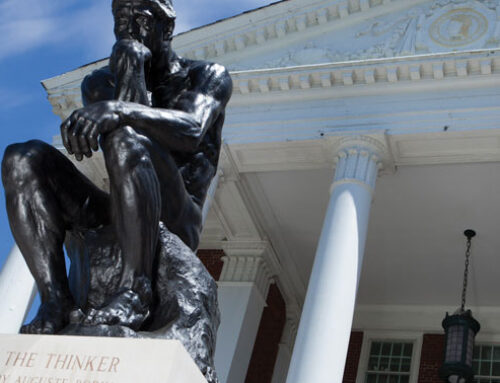“The White Rose” written by Lillian Groag passionately executed an externally and internally complicated story of the simple moral standing up for what is right. Brilliantly presented by the University of Louisville’s Department of Theatre Arts, “The White Rose” told a story of pride and honor based on a real historic event in the year of 1943 at the height of the Nazi regime during World War II.
The play revolves around a group of students including the radical Hans Scholl (Patrick Taft) and his sister Sophie Scholl (Margaret Streeter) from the University of Munich. In the play and historically, the students write pamphlets campaigning and expressing their opposition of Adolf Hitler’s Nazi regime. They do this anonymously under the name of “White Rose.” The newly assigned head of the Munich Gestapo, Robert Mohr (Will Crawford), investigates the group of students after they had been caught passing out the leaflets in the main hall of the university.
Under the direction of Russell Vandenbroucke, the politically-themed play explored and branched the deep roots of personal belief. The acting of the entire cast members was beyond outstanding. Taft played the role of Hans with such passion that clearly conveyed the character’s desire for Germany’s freedom. Streeter’s acting pierced the hearts of the audience as she cried for what is right. And last but not least, Crawford played the Gestapo head with such intensity, fighting the most humanly innate self-conflict of being indifferent or caring. With a talented cast, the script was powered by the character interaction and conversation that guided the audience into five days of “The White Rose” world.
The actors may have lead the story, but the scenery, lighting and costume design is what brought the whole production together. Michael Hottois’ set design used dull earth tones to reflect the times of World War II. The clever use of the stage and lighting smoothly transitioned the scenes and time. The use of warm lights during the flashblacks and cool lights to represent a concurring event made a potentially confusing script into a great production. The costumes designed by Donna Lawrence-Downs not only reflected the war times, but also the individual characters. The sweaters and collared shirts subtly showed the intellectual sides of the students, and the typical work clothes conveyed Mohr as an everyday man who works hard to survive the harsh realities of life.
The production portrayed the historic and heroic acts of a handful of students who fought and continued to fight, knowing the consequences of high treason. To show this in theater and stir up the emotions of the audience successfully even with its underlying politics was astounding. The story reminds us that throughout history, what brings rise to tyranny such as Hitler is the general population’s lack of action, but its the bravery of a few people that set the example of what we should strive for. The White Rose is one of those rare plays that not only appeals but also educates and reminds.
“The White Rose” was simply a great production that everyone should experience. The conversation-driven plot, the character interactions, the clever uses of the stage and set, and history are only a few reasons to immerse yourself into the fives days of 1943. “The White Rose” is truly an epic play.
[email protected]
Photo courtesy louisville.edu





